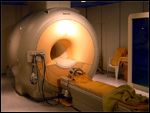MRI Screening in BRCA1 or BRCA2 Carriers May Reduce Breast Cancer Mortality
In a prospective study published online first on March 28, 2011 in the Journal of Clinical Oncology, researchers have shown, for the first time, that annual MRI screenings can reduce breast cancer-related mortality in women with a BRCA1 or BRCA2 mutation.
In a prospective study published online first on March 28, 2011 in the Journal of Clinical Oncology (DOI:10.1200/JCO.2009.27.0835), researchers have shown for the first time, that annual MRI screenings can reduce breast cancer-related mortality in women with a BRCA1 or BRCA2 mutation. Women who are carriers of a mutation in either BRCA1 or BRCA2 have a higher risk for developing breast cancer over their lifetime, so annual screenings, including MRIs, are recommended for this population in order to detect early, treatable disease.

Modern high field clinical MRI scanner. Source: Wikimedia Commons user KasugaHuang.
The authors of the study, who are at the Women's College Research Institute at the University of Toronto, monitored 1,275 women, 445 in the MRI screening group and 830 in a conventional screening group at multiple centers in North America. Women were followed for up to 6 years for incidence of breast cancer.
Women in the MRI screening group underwent a clinical breast exam, mammography, ultrasonography, and MRI annually while women in the conventional screening group had annual clinical breast exams and mammography.
After an average follow-up of 3.2 years, the cumulative incidence of breast cancer was similar for both groups. 9.2% of the women in the MRI-screened cohort and 9.2% of the comparison group had breast cancer. When the study authors parsed the cancers by stage, however, they found that the incidence of late-stage breast cancer was higher in the conventionally screened cohort. 1.9% of the MRI-screen group had stage II-IV breast cancer while 6.6% of the comparison group had advanced stage breast cancer (P = 0.02). The hazard ratio for developing stage II-IV breast cancer, adjusted for age, BRCA mutation, breast cancer history, and estrogen use, was 0.3 (P = 0.008).
Notably, of the 41 women in the MRI group that were diagnosed with cancer, 40 were diagnosed by MRI and 1 was identified by self-examination. In contrast, 25 of the 76 women with breast cancer in the comparison group were diagnosed by screening and 38 were detected examination (32 by self-exam and 6 by clinical exam). Additionally, invasive tumors in the MRI group were smaller upon diagnosis compared to the conventional screening group.
This prospective study supports previously published reports that had indicated increased sensitivity of breast MRI in detecting early breast cancers versus mammography. More research is still needed to verify the result and whether MRI screenings reduce mortality due to breast cancer in all women.